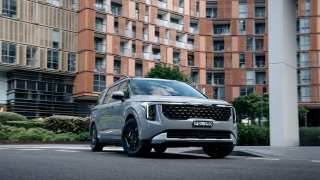
HSV GTS v Mercedes-Benz E63 2013
- HSV GTS
- Mercedes-Benz E-Class
- Mercedes-AMG E63
- HSV GTS 2013
- Mercedes-Benz E-Class 2013
- Mercedes-Benz E63 2013
- HSV GTS Reviews
- Mercedes-Benz E-Class Reviews
- Mercedes-AMG E63 Reviews
- HSV Reviews
- Mercedes-Benz Reviews
- HSV Sedan Range
- HSV Wagon Range
- Mercedes-Benz Sedan Range
- Mercedes-Benz Wagon Range
- Sedan
- Wagon
- HSV
- Mercedes-Benz
- Sports cars
- Prestige & Luxury Cars
- Comparison
Australians love an underdog whether it’s on the sporting field or in Hollywood. But when it comes to cars we have few opportunities to strut our stuff. The arrival of the new HSV GTS -- the fastest and most powerful production car ever designed, engineered and built in Australia -- is our best chance yet at hitting the big time. And not a moment too soon.
As reported earlier the new HSV GTS is a fitting exclamation point for the Australian car industry. The 2017 ‘Commodore’ will likely be a globally-developed hum-drum front-drive sedan that’s about as Australian as a Toyota Camry.
We’ve been blown away by the performance and refinement of the new supercharged HSV GTS but what we really wanted to know is how it compares on a global stage. With all due respect to the highly capable Ford Falcon GT -- in particular the limited edition R-Spec version released last year -- the new HSV GTS has moved beyond the decades-old Ford v Holden comparisons.
Both local hero cars may have supercharged V8s but the hot Holden and all its technology (forward crash alert, heads-up display, blind-zone warning, self-parking and cross traffic alert when reversing) means it really is in another league these days.
There really is only one rival, the twin-turbocharged Mercedes-Benz E63 S-AMG. It’s a bit of a tongue twister but the ‘S’ is important. It’s not just any E63 but the updated 2014 model with an optional Sports pack (standard in Australia) that delivers the same power as the HSV GTS (430kW) but an epic 800Nm of torque from its twin turbocharged 5.5-litre V8 (instead of the HSV’s also-considerable 740Nm from its supercharged 6.2-litre V8).
With those numbers the Mercedes absolutely flattens the fast sedans from Audi and BMW; by comparison they look plain pedestrian. That only leaves the small matter of a rather large price difference, a pair of keys and an open road to explore.
PERFORMANCE
Don’t worry we won’t keep you in suspense. The HSV GTS is a fraction slower to the speed limit than the Mercedes-Benz E63 S-AMG. But the Mercedes’ 0.3-second advantage costs $150,000 -- or $50,000 for every 0.1 of a second if we use the manufacturer claims as the benchmark. HSV says the GTS can reach 100km/h in 4.4 seconds, Mercedes says its car in “launch mode” can achieve the same feat in 4.1 seconds. We didn’t get near either time in either car.
We squeezed a 4.7-second time out of the manual HSV GTS and a 4.5-second time out of the automatic Mercedes-Benz. So a $75,000 difference per 0.1-second then. Both cars struggled to get grip off the line despite wearing identical Continental tyres (20-inch diameter on the HSV, 19-inch on the beastly Benz). They both used electronic wizardry to try to ration their power as gently as possible but it turns out you just can’t keep good engines down. And power really is nothing without control.
A sidenote, we actually got a better time out of the GTS by launching it ourselves rather than in HSV’s launch mode (press a button, step off the clutch and hope for the best; we got repeatable 4.8-second times if you’re curious).
We’re assured the automatic HSV GTS is slightly quicker than the manual version and we believe it, especially as the manual needs to grab second gear just before it eclipses the 100 mark. Can you feel the acceleration difference between the two? Can you #@*% what. The Mercedes’s twin turbo 5.5-litre V8 has much more oomph from lower revs and the adrenaline boost lasts longer.
What the 0 to 100km/h times don't show is how the Mercedes in much more toey, more ready to launch at any moment from whatever speed you're doing with just the slightest dab of the throttle. Its in-gear acceleration is significantly quicker than the HSV.
The only minor letdown with the Benz is the gearbox. Mercedes’ seven-speed multi-clutch auto can be a little sluggish between gears when it’s not being floored (even with four shift modes to choose from). The HSV is no slouch but the Mercedes-Benz E63 S-AMG snots it in the right conditions. The power is, quite simply, more readily available.
PRICE
Would a Mercedes customer ever consider a Commodore? Don’t scoff until you’ve sat in the new Holden. The HSV GTS has a much more upmarket feel to it. Sure, few potential buyers of either of these cars are going to cross-shop them. The only downside is that, inside, the GTS looks exactly the same as the HSV Clubsport R8. In the GTS you’re paying for an engine, a heavy-duty differential, a gaping front bumper, big yellow brakes and three years of engineering work.
If you can comfortably afford a Mercedes-Benz E63 S-AMG then there really is no need to consider anything else -- from Germany or Australia. But if you simply can’t bring yourself to part with a quarter of a million dollars on a car that, unlike property, will ultimately go down in value, then the HSV GTS may be for you. It may even hold a little more value in the long run given that it’ll mark the end of an era in Australian muscle cars.
In isolation the new HSV GTS seems expensive but when you consider it in this company the numbers start to add up. You could buy a manual and an automatic GTS and still have change from the purchase price of the Mercedes-Benz.
The HSV GTS starts at $92,990 plus on-road costs. The price of the Mercedes-Benz has crept up $9500 to $249,900 but comes with the lot, including an AMG diff and the power upgrade (from 410kW/720Nm to 430kW/800Nm) that other countries must pay a hefty premium for.
HANDLING
Both of these cars can easily handle the daily grind or a race track. The HSV GTS rides on suspension technology shared with Ferrari; tiny magnetic particles adjust the amount of damping in milliseconds. The result is the most comfortable HSV to date despite riding on massive 20-inch wheels and tyres. The press of a button makes it switch from being suited to track work or city cruising.
The Mercedes-Benz is just as comfortable and adjustable but without as many gadgets. The slightly lighter and lower body of the E63 means it doesn’t lean as much in corners as does the big Commodore. The Mercedes just feels lower and more agile.
The biggest surprise, however, was the difference in braking performance. The HSV GTS has the biggest brakes ever fitted to an Australian production car (390mm discs up front, clamped by six-piston calipers, just in case such detail comes in handy on a trivia night) and they feel utterly superb.
The brakes, sourced from AP Racing but wearing a HSV label, have a level of precision that makes the mighty GTS feel as lithe as one of those tiny hand-built club cars with frames that appear to be made out of old tube steel offcuts.
The Benz has smaller brakes (360mm discs and six-piston calipers up front) but has slightly less weight to pull up. As hard as this is to believe, however, especially for Euro-philes, the Benz brakes feel quite basic in comparison, lacking the bite and precision of millimetre perfect adjustment of the HSV.
VERDICT
Patriotic pride and price differences aside the Mercedes-Benz E63 S-AMG is a knockout winner -- not least of which is because it highlights the many strengths of the homegrown HSV GTS. This is the closest an Australian car has ever been to matching the world’s best sports sedan, which is all the more remarkable given the $150,000 price difference. If this were a World Cup soccer match, the score would be Germany 2, Australia 1. That we landed one in the net against a bigger team with a vastly bigger budget is a victory in its own.
This reporter is on Twitter: @JoshuaDowling

HSV GTS
Price: $92,990 plus on-road costs
Engine: Supercharged 6.2-litre V8
Power: 430kW and 740Nm
Transmission: Six-speed manual or six-speed torque converter auto ($2500 option)
Weight: 1881kg (manual), 1892.5kg (auto)
Safety: Six airbags, five-star ANCAP rating
0 to 100km/h: 4.4 seconds (claimed), 4.7 seconds (as tested)
Consumption: 15.7L/100km (auto), 15.3 L/100km (manual)
Warranty: 3 years, 100,000km
Service intervals: 15,000km or 9 months
Spare tyre: Full size (above boot floor)
Mercedes-Benz E63 S-AMG
Price: $249,900 plus on-road costs
Engine: Twin-turbo 5.5-litre V8
Power: 430kW and 800Nm
Transmission: Seven-speed multi-clutch auto
Weight: 1845kg
Safety: Eight airbags, five-star Euro-NCAP rating
0 to 100km/h: 4.1 seconds (claimed), 4.5 seconds (as tested)
Consumption: 10L/100km
Warranty: 3 years, unlimited km
Service intervals: 20,000km / 12 months
Spare tyre: inflator kit
Pricing guides
Range and Specs
| Vehicle | Specs | Price* | |
|---|---|---|---|
| E400 | 3.0L, —, 7 SP AUTO | $34,100 – 40,590 | 2013 Mercedes-Benz E-Class 2013 E400 Pricing and Specs |
| E400 | 3.0L, —, 7 SP AUTO | $30,360 – 36,630 | 2013 Mercedes-Benz E-Class 2013 E400 Pricing and Specs |
| E500 Elegance | 4.7L, —, 7 SP AUTO | $36,300 – 43,230 | 2013 Mercedes-Benz E-Class 2013 E500 Elegance Pricing and Specs |
| E500 Avantgarde | 4.7L, —, 7 SP AUTO | $36,300 – 43,230 | 2013 Mercedes-Benz E-Class 2013 E500 Avantgarde Pricing and Specs |
$17,999
Lowest price, based on 41 car listings in the last 6 months


















